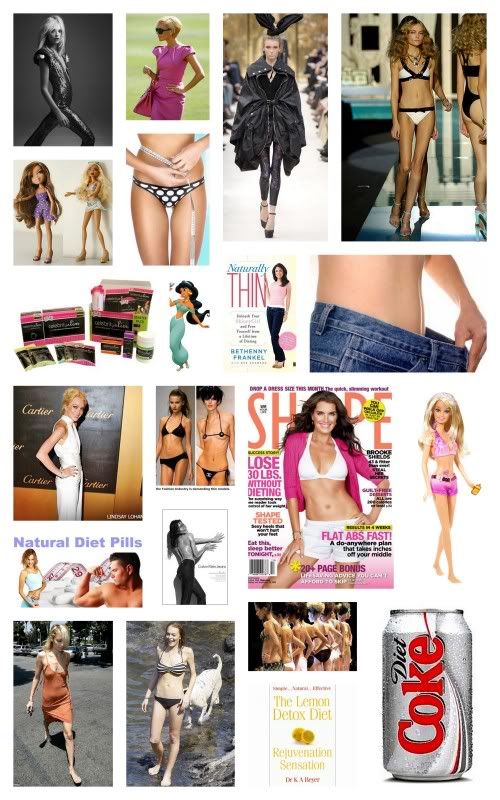An abundance of research has shown a concerning rise in body dissatisfaction, unhealthy dieting patterns as well as eating disorders in young people. The EDFV (2009) found that onset of anorexia is generally in adolescence and a staggeringly 68% of 15 year old females are on a diet. The National Eating Disorder Association reported that 91 percent of women on college campuses across a range of universities in the U.S. are on a diet (Eating Disorders, 2009). In a study to determine at what age young girls had a desire for thinness, the British Journal of Health Psychology from May 2003 concluded that the age in young girls was approximately age 6 (Lowes and Tiggemann, 2003).
Many people believe the media messages don’t affect the lives of young people, yet much research has shown a correlation between this rise in body concerns and exposure to the types of media discussed in earlier posts. Garfinkel and Garner (1982) argue that television and magazines portray thin characters as more successful and personally effective than overweight characters in a variety of endeavors which increase the attractiveness of thin characters (cited in Harrison 1997).
Peterson, Paulson & William’s 2007 study examines the relations of adolescents' perceptions media pressures with the development of eating disorder symptoms. Results by Field et al (2001) the development of weight concerns and weight control practices among preadolescents and adolescents are influenced by the media. In a survey of female undergraduate students Harrison (1994) found that about 15 percent of the women met criteria for disordered eating, signs of anorexia or bulimia, body dissatisfaction, as well as a drive for thinness, perfectionism and a sense of personal ineffectiveness. In a later study, Harrison (1997) also showed that magazine reading and television viewing, especially exposure to thinness supporting media, significantly predict symptoms of women's eating disorders. Reading fashion magazines in particular is notably related to a woman's strive for thinness and body dissatisfaction (DeGroat).
A study by Bearman, Martinez and Stice (2006) discovered that body dissatisfaction could be predicted among adolescents exposed to such media. They showed that in terms of body dissatisfaction, significant increases for girls were present during early adolescence, the rates increased over the three years that the study was conducted.
This stereotype emphasizing the importance of physical attractiveness categorically linked with thinness is inescapable. The following images are just a small way in which adolescents and children are pounded by thinness depicting and thinness promoting media on a daily basis.

"It see ms clear that young women's patterns of disordered eating, including both attitudinal and behavioural tendencies, are related not only to the types of media they expose themselves to, but also to the way they perceive and respond to specific mass media characters…. This relationship may seem obvious to readers who are concerned with this issue and openly acknowledge the possibility that the media operate as transmitters of potentially dangerous socially desirable values and norms.” (Harrison 1997)
These messages and images may not directly cause an eating disorder but they shape girls’ negative attitudes of body image and lower self esteem and trigger dieting obsessions that often lead to full blown eating disorders. And it is absurd to think that counter messages, we trying to disseminate in health classes in our schools saying “all shapes are ok” are having a positive effect. Clearly, society doesn’t mean it – because the media continues to promote the anorexic look (Deanne 2009)
These images along with past research underscore the insidious influence of the media on self image. The standards that the media sets in terms of body shape and appearance are taken on by a large proportion of individuals. The images the media present us become goals to aspire to, in order to be deemed attractive. It is further promoted through images in gossip magazines putting down celebrities who have gained weight and praising those who have “slimmed up and trimmed down”. Through the products that are available which have “diet” and “fat free” written all over them. The advertisement of diet products, pills and shakes. The effect it is having on young woman is clear, poor body image, body dissatisfaction and the development of eating disorders.
Bearman, S.K., Presnell, K., & Marinez, E. (2006). "The skinny on body dissatisfaction: A longitudinal study of adolescent girls and boys." Journal of Adolescence 2006 April; 35(2): 217–229.
Viewed 7th September
Deanne, J . "Eating Disorders and the Media." (February 10, 2002).
viewed 10th October
DeGroat, Bernie (1997). Media influence eating disorders.
viewed 10th October
"Eating Disorders." (January 28, 2009). Sober Recovery.
viewed 10th October
Eating Disorders Foundation of Victoria (EDFV)
viewed on 10th August 2009
Field, A, Camargo, A, Taylor, B, Berkey ,C, Roberts, S and Colditz, G (2001)
Peer, Parent, and Media Influences on the Development of Weight Concerns and Frequent Dieting Among Preadolescent and Adolescent Girls and Boys
PEDIATRICS Vol. 107 No. 1 January 2001, pp. 54-60
Lowes, J, Tiggemann, M. (2003). Body dissatisfaction, dieting awareness and the impact of parental influence in young children. British Journal of Health Psychology, Vol. 8 Issue 2. viewed 10th September
Nostrand, J V, (2001) Eating Disorders: Eating Disorders: How the Media Have Influenced Their Development In Adolescent Girls
viewed 10th October
Peterson, K, Paulson, S & Williams, K (2007)
Relations of Eating Disorder Symptomology with Perceptions of Pressures from Mother, Peers and Media in Adolescent Girls and Boys
Sex Roles: A Journal of Research, vol. 57, no. 9-10

No comments:
Post a Comment